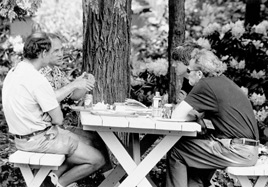2000: Biological Responses to DNA Damage, Vol. LXV
Organizer: Bruce Stillman
There are few times in science when all the planets align, allowing what were apparently different areas of investigation to come together to present a new view of a field. Such appeared to be the case for the varied fields that focused on the diverse aspects of the biological responses to DNA damage. DNA repair, genotoxic stress, telomere maintenance, and cell division cycle checkpoint control were not so long ago fields of research that did not obviously overlap. Now they are so intertwined that ignoring developments in any one area would limit oneâs view of how cells respond to biological damage. Indeed, Barbara McClintockâs long held notion that the genome can sense what is going on in its environment does not now appear to be far from the truth. Moreover, understanding DNA damage control is providing great insight into the mecha¬nisms of cancer progression because cancer is a disease caused by genome instability. Perhaps most surprisingly, genome damage controls are now intimately tied into pathways that, when altered, cause premature aging of cells and when overexpressed, promote life extension. Combining these areas of research into a single symposium was too much of an opportunity to pass by.
There has not been a Cold Spring Harbor Symposium devoted entirely to this topic, which is perhaps surprising since Evelyn Witkin initiated studies with Milislav Demerec on ultraviolet-induced mutations in bacteria at Cold Spring Harbor in 1944. This ultimately led to her major contributions to uncovering the SOS response. Discussion of the nature of mutations and genetic damage was pervasive at Cold Spring Harbor in the 1940s and 1950s due to the presence of Demerec, Max Delbrück, Salvador Luria, and Barbara McClintock and can be traced to the 1941 Symposium on âGenes and Chromosomes: Structure and Organization,â which occurred long before the double helix was revealed. We have come a long way in our understanding since then, and it was about time to correct the long absence of this topic from these Symposia.
For help in organizing this Symposium, I must thank many people, but first and foremost David Stewart. He provided valuable advice and help with researching the topic, and his staff in the Meetings and Courses office, particularly Diane Tighe and Mary Smith, provided flawless suppport that is most appreciated. Indispensable advice on the program was also obtained from
| 
Thomas Lindahl, Richard Wood, Graham Walker, Errol Friedberg, Titia de Lange, and Carol Prives. I also thank Errol for agreeing to summarize the meeting and presenting a wonderful overview of the field, both past and present, in the summary at the end of this volume. The first night introductory lectures were presented by Graham Walker, Steve Elledge, Elizabeth Blackburn, and Fred Alt. The Reginald G. Harris lecture was presented by Arnold Levine, who has made major contributions to the discovery and understanding the p53 tumor suppressor protein that has a significant role in DNA damage responses. Finally, Jan Hoeijmakers informed our neighbors and friends in a masterful Dorcas Cummings Lecture that preceded the annual dinner parties at the homes of local residents.
The final program contained 67 oral presentations and 239 poster presentations, all of which were of very high quality science. More than 450 participants packed the Grace Auditorium for this Symposium.
The staff in the Cold Spring Harbor Laboratory Press, particularly Joan Ebert and Dorothy Brown, have ensured that this volume was published in a reasonable time, given the number of authors that they must deal with. We are always dependent on the generous support from the Federal funding agencies, particularly the National Cancer Institute, a branch of the National Institutes of Health. Equally importantly, we must thank the corporate sponsors who support this meeting and the other CSHL meetings, and they are listed on the following page. Without their support, our strong and broad meetings program would not be as valuable as it is.
— Jan A. Witkowski |